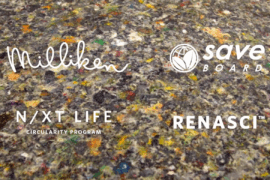To start the new year, our editor was on the ground in the UK to meet some of London’s leading architects. What are the relevant insights for Australia and the Asia-Pacific?

80 Charlotte Street, London by Make Architects, photograph by Jack Hobhouse.
January 15th, 2024
1. Old and new
The rich urban fabric of a city such as London necessitates dealing with many layers of history. Those layers are many and long, while the demands of the present and future are certainly not letting up.
Projects comparable to Melbourne’s Olderfleet, by Grimshaw with Carr, seem to be everywhere, at least around the City. Large new buildings are on a totally different scale to some of the surrounding built environment, some of which dates back almost a thousand years. That’s nothing new in this city, but the rate of its development has increased. The additions are wrapping themselves around the older fabric, but also going out of their way to include them – often as entry points, for example at 40 Leadenhall by Make Architects.

2. Premium offices
The large new buildings in question are mostly workplaces. More specifically, it’s A-grade office space designed from the beginning with two important things in mind: first, high-end and varied amenities such as hospitality or wellness spaces; second, an in-built flexibility and adaptability to (hopefully) accommodate evolutions in workplace design that are surely yet to come.
In the context of post-pandemic working from home, we already know about the need to ‘earn the commute’ and the general increase in workplace flexibility The smart designers have this in mind with their client pitches: when it comes to workplace in 2024, it’s all or nothing. Go hard or go (and work from) home, if you will.
The buildings attracting high tenant demand are those with high-end, cutting-edge workplace offerings. The multifaceted, adaptable, amenity-rich office seems to have become more necessity than luxury.
3. Back to basics
Translating that message of high-end amenity and adaptability into concrete design might start to summon images of sci-fi, high-tech, gimmicky buildings. However, as we recently argued with regard to climate in INDESIGN magazine’s 90th issue, the most urgent problems don’t necessarily demand the most complex solutions – just the right ones.
Large new office buildings, for example, need to plan first and foremost in terms of orientation. Glass boxes don’t do so well in either London’s rainy cold or Brisbane’s tropical humidity, but introducing side-core planning or relevant shading can help.
Designing for the possibility of future change that is by definition unknown at present can also mean stripping things back programmatically. Larger ceiling heights, for instance, are a straightforward move that allows for a wider range of potential uses in the future.
Related: 5 things we learned at the 2023 World Architecture Festival

4. The local palette
It’s been said of Brutalism that what dazzles in the Mediterranean light of Marseille might in fact fall flat in greyer northern European skies. London is a city of often charming brick construction with more copious amounts of glass, concrete and steel in recent decades. The heavily metallic additions to the City have a certain drama, but also perhaps a coldness.
It makes one remember that what often differentiates our part of the world is local climatic and material conditions – the sunlight, heat, lush vegetation and sometimes warm materiality. Australia’s strength is, in part, surely tied up with the ability to design with materials that pay homage to the setting. Sydney sandstone, for example, or green walls that celebrate native planting.
5. Landscape architecture
All of which reminds us that Australia-Asia-Pacific has, in its landscape architecture, unique opportunities to shape the built environment. As we recently discussed with Victoria-based Phillip Withers, it’s past due time for Australia to move past its ideas of the tamed European garden and instead embrace native species.
Like the point above, this isn’t so much a negative comment on London as a realisation of the positive opportunities for local differentiation that exist in Australia. London reminds us that Australian and Asian cities are in totally different places and should celebrate that fact.

6. Private security guards ruin public space
On a final note, a thought about who occupies the spaces between buildings in our cities. Once you start to notice the individuals posted around every lobby entrance, courtyard, walkway and passage in the City of London, it’s hard to stop. The ‘CBD’ has been adding buildings rapidly in recent years and the mixture of huge glass skyscrapers, medieval churches and small streets makes for an alluring and dramatic set of public spaces. However, what happens to those spaces when private security guards stand on every corner?
It seems to add a menacing undercurrent of hostility, or at least a limit to the openness of the spaces as public spaces – one that finds its corollary in the number of homeless people on the streets. A system that needs private security guards while creating countless homeless people can produce only limited public or civic space, if any at all. It’s an issue that architecture and design can only influence in very limited ways but, on the scale of urban planning and the city as a whole, we’d all do well to remember and cherish what makes those spaces in between valuable – their openness, the chance to pass through and linger at whim, organic meetings and spontaneous experiences. Australia seems to be behind on this trend but it’s something for all those who care about urban space to keep in mind.

INDESIGN is on instagram
Follow @indesignlive
A searchable and comprehensive guide for specifying leading products and their suppliers
Keep up to date with the latest and greatest from our industry BFF's!

How can design empower the individual in a workplace transforming from a place to an activity? Here, Design Director Joel Sampson reveals how prioritising human needs – including agency, privacy, pause and connection – and leveraging responsive spatial solutions like the Herman Miller Bay Work Pod is key to crafting engaging and radically inclusive hybrid environments.

Welcomed to the Australian design scene in 2024, Kokuyo is set to redefine collaboration, bringing its unique blend of colour and function to individuals and corporations, designed to be used Any Way!

A longstanding partnership turns a historic city into a hub for emerging talent

Gaggenau’s understated appliance fuses a carefully calibrated aesthetic of deliberate subtraction with an intuitive dynamism of culinary fluidity, unveiling a delightfully unrestricted spectrum of high-performing creativity.

Melbourne is the destination and Saturday 6th September is the date – get ready for this year’s one-day design extravaganza with a full guide to what’s on.

‘What a Ripper!’ by comedian and architecture advocate Tim Ross explores Australia’s rich legacy of local product design.
The internet never sleeps! Here's the stuff you might have missed

To mark a full year of Bradhly Le’s young studio, the team at RIZEN Atelier share their impressions and inspirations so far.

Developed by Milliken in partnership with saveBOARD, Renasci™ is a breakthrough circular flooring product made from carpet and soft plastics waste – designed to be repeatedly recycled.
Please note: by submitting this form you will be added to the Indesignlive.com mailing list.